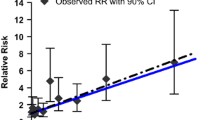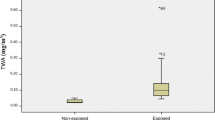Abstract
Occupational exposure to hexavalent chromium (Cr+6) has reported in different industries. The Cr6+ has the carcinogenic and non-carcinogenic effects. The aim of this study was to provide a meta-analysis and health risk assessment of occupational exposure to Cr6+ in Iranian workplaces. Databases including Scopus, Web of Sciences (WOS), and Scientific Information Database (SID), as a national database, were searched from 2000 to February 2021. The related studies to occupational exposure to Cr6+ were selected by Preferred Reporting Items for Systematic Reviews and Meta-Analyses (PRISMA) protocol. Lung cancer and non-cancer risk (nasal mucosal irritation, atrophy, and perforation) of Cr6+ were estimated by Environmental Protection Agency (EPA) method, based on the Monte Carlo simulation (MCS). Also, the results of spirometry and biomonitoring of previous studies were reviewed. We found 14 articles based on inclusion criteria. Pooled concentration of Cr6+ was estimated 0.037 ± 0.002 mg/m3 which was higher than the recommended exposure limit by the ACGIH (0.002 mg/m3). The mean lung cancer risk was estimated to be 5.49E-2, which was considerable risk. In the Cr6+-exposed workers, all parameters of pulmonary function had decreased. The level of Cr6+ in urinary and blood samples was higher than threshold limit. Results indicated that exposure to Cr6+ and its health risk were more than recommended exposure limit. The results of present study could be helpful for health policy maker to control exposure to Cr6+ in workplaces.





Similar content being viewed by others
Data Availability
All data generated or analyzed during this study are included in this published article.
References
Isıklı B et al (2003) Effects of chromium exposure from a cement factory. Environ Res 91(2):113–118
McDermott S et al (2015) Systematic review of chromium and nickel exposure during pregnancy and impact on child outcomes. J Toxicol Environ Health A 78(21–22):1348–1368
Seidler A et al (2013) Systematic review and quantification of respiratory cancer risk for occupational exposure to hexavalent chromium. Int Arch Occup Environ Health 86(8):943–955
Pesch B et al (2018) Exposure to hexavalent chromium in welders: results of the WELDOX II field study. Ann Work Expos Health 62(3):351–361
Golbabaie F et al (2007) Feasibility of biological monitoring for evaluating of exposure to Cr6 in electroplating workshops. J Sch Public Health Inst Public Health Res 5(3):15–22
Mozafari P et al (2016) Feasibility of biological effective monitoring of chrome electroplaters to chromium through analysis of serum malondialdehyde. Int J Occup Environ Med 7(4):199
Hazrati S, RezazadehAzari M, Fazlzadeh M (2016) Evaluation of workers exposure to hexavalent chromium compounds in a cement industry. J Occup Environ Health 1(1):35–40
Rasoul GMA et al (2017) Health-related disorders on occupational exposure to chromium in a leather tanning factory (Menoufia, Egypt). Menoufia Med J 30(1):92
Fazli Z et al (2017) Non-carcinogenic risk assessment of occupational exposure to hexavalent chromium in two. J Health Field 4(1):18–24
Zhang X-H et al (2011) Chronic occupational exposure to hexavalent chromium causes DNA damage in electroplating workers. BMC Public Health 11(1):224
Fazli Z et al (2016) Occupational and environmental risk assessment of inhalation exposure to hexavalent chromium for cancerous effects. J Occup Environ Health 2(3):181–190
Golbabaei F et al (2012) Assessment of welders exposure to carcinogen metals from manual metal arc welding in gas transmission pipelines, Iran. Iran J Public Health 41(8):61
Higgins JP et al (2019) Cochrane handbook for systematic reviews of interventions. John Wiley & Sons
Agrawal A, Rasouli M (2019) Creating bibliographies using endnote. EndNote 1-2-3 Easy! Springer, pp 211–276
Liberati A et al (2009) The PRISMA statement for reporting systematic reviews and meta-analyses of studies that evaluate health care interventions: explanation and elaboration. J Clin Epidemiol 62(10):e1–e34
Pierce CA (2008) Review of comprehensive meta-analysis (version 2.2.027). Organ Res Methods 11(1):188–191. https://doi.org/10.1177/1094428106296641
Ras RT et al (2013) Flow-mediated dilation and cardiovascular risk prediction: a systematic review with meta-analysis. Int J Cardiol 168(1):344–351
Kuroki T et al (2017) Legionella prevalence and risk of legionellosis in Japanese households. Epidemiol Infect 145(7):1398–1408
Nasirzadeh N, Mohammadian Y, Fakhri Y (2020) Concentration and cancer risk assessment of asbestos in Middle East countries: a systematic review-meta-analysis. Int J Environ Anal Chem 7:1–5. https://doi.org/10.1080/03067319.2020.1856375
ACGIH (2011) Guide to occupational exposure values. Cincinnati, OH: American Conference of Governmental Industrial Hygienists, Publication No. 0389
IARC (1990) IARC monographs on the evaluation of carcinogenic risks to humans, chromium, nickel and welding. Based on a Meeting Held in LyonL 49
EPA (2004) Risk assessment guidance for superfund. Human Health Evaluation Manual (Part A) 1:1–89
EPA (2011) Exposure factors handbook: 2011 edition. National Center for Environmental Assessment, Washington, DC, EPA/600/R-09/052F, pp 1–466
Zarandi SM et al (2019) Concentration, sources and human health risk of heavy metals and polycyclic aromatic hydrocarbons bound PM 2.5 ambient air, Tehran, Iran. Environ Geochem Health 41(3):1473–1487
Dehghani M et al (2018) Characteristics and health effects of BTEX in a hot spot for urban pollution. Ecotoxicol Environ Saf 155:133–143
EPA (2017) Use of Monte Carlo simulation in risk assessments. Region 3 technical guidance manual, risk assessment. Available at https://www.epa.gov/risk/use-monte-carlo-simulation-risk-assessments. Accessed 14 Aug 2021
Rubinstein RY, Kroese DP (2016) Simulation and the Monte Carlo method, 2nd edn. John Wiley & Sons 10:279–311
Fakhri Y et al (2019) The concentration of potentially toxic elements (PTEs) in honey: a global systematic review and meta-analysis and risk assessment. Trends Food Sci Technol 91:498–506
Golbabaei F et al (2007) Feasibility of biological monitoring for evaluating of exposure to cr6 in electroplating workshops. J School Public Health Institute Public Health Research 5(3)15–22
Zendehdel R, Fazli Z, Rezazadeh Azari M (2019) Neurological risk assessment of co-exposure to heavy metals (chromium and nickel) in chromium-electroplating workers. Work 63(3):355–360
Zare S et al (2017) Designing, constructing and installing a local exhaust ventilation system to minimize welders’ exposure to welding fumes. Arch Hyg Sci 6(4):356–362
Mousavian NA, Mansouri N, Nezhadkurki F (2017) Estimation of heavy metal exposure in workplace and health risk exposure assessment in steel industries in Iran. Measurement 102:286–290
Jafari AJ, Assari MJ (2004) Respiratory effects from work-related exposure to welding fumes in Hamadan, Iran. Arch Environ Health Int J 59(3):116–120
Pouransari M (2020) Risk assessment of occupational exposure to heavy metals (lead, chromium, cadmium) in cement respirable particles in a cement factory. Iran Occup Health 17(1):1–13
Dehghan SF, Mehrifar Y (2019) Occupational exposure to welding fumes and gases during different arc welding processes. Int J Occup Hyg 11(2):136–45
ACGIH (2018) TLVs and BEIs: based on the documentation of the threshold limit values for chemical substances and physical agents & biological exposure indices. Cincinnati, Publication No:45240–4148
Honaryar MK et al (2019) Welding fumes and lung cancer: a meta-analysis of case-control and cohort studies. Occup Environ Med 76(6):422–431
Sorahan T et al (1998) Lung cancer mortality in nickel/chromium platers, 1946–95. Occup Environ Med 55(4):236–242
Sciannameo V et al (2019) Cancer mortality and exposure to nickel and chromium compounds in a cohort of Italian electroplaters. Am J Ind Med 62(2):99–110
Shouroki FK et al (2018) Biological monitoring and lung function assessment among workers exposed to chromium in the ceramic industry. J Res Health Sci 18(1):408
Neghab M et al (2015) Acute and chronic respiratory effects of chromium mists. J Health Sci Surveill Syst 3(3):119–124
Pourtaghi G et al (2009) Pulmonary effects of occupational exposure to welding fumes. Aust J Basic Appl Sci 3(4):3291–3296
Omland Ø et al (2014) Occupational chronic obstructive pulmonary disease: a systematic literature review. Scand J Work Environ Health 40 (1):19–35
König P et al (2018) Is an FEV1 of 80% predicted a normal spirometry in cystic fibrosis children and adults? Clin Respir J 12(8):2397–2403
Medbø A, Melbye H (2007) Lung function testing in the elderly—can we still use FEV1/FVC< 70% as a criterion of COPD? Respir Med 101(6):1097–1105
Huang Y-L (1999) Lipid peroxidation in workers exposed to hexavalent chromium. J Toxicol Environ Health A 56(4):235–247
Pan C-H, Jeng HA, Lai C-H (2018) Biomarkers of oxidative stress in electroplating workers exposed to hexavalent chromium. J Expos Sci Environ Epidemiol 28(1):76–83
Muller CD et al (2020) Occupational risk assessment of exposure to metals in chrome plating workers. Drug Chem Toxicol 1–8. https://doi.org/10.1080/01480545.2020.1731527
Liu H-H et al (2009) Health risk assessment by measuring plasma malondialdehyde (MDA), urinary 8-hydroxydeoxyguanosine (8-OH-dG) and DNA strand breakage following metal exposure in foundry workers. J Hazard Mater 170(2–3):699–704
Hashim Z et al (2015) Occupational risk and relationship between chromium and nickel in metal working fluid with chromium and nickel levels in blood and urine among machinists in Negeri Sembilan, Malaysia. Int J Sci Basic Appl Res 21:38–59
Acknowledgements
We would like to express our special appreciation people who helped to collecting and analyzing data in this study. Especially Mrs. Zahra beigzadeh, Ph.D student of occupational health engineering at Tehran University of medical sciences.
Author information
Authors and Affiliations
Contributions
All authors contributed to the study conception and design. Data collection was performed by Golnoush Dehgan, and analysis was performed by Nafiseh Nasirzadeh and Yousef Mohammadian. The first draft of the manuscript was written by three authors, and all authors commented on previous versions of the manuscript. All authors read and approved the final manuscript.
Corresponding author
Ethics declarations
Ethics Approval
We had not applied for ethics committee approval, as it was based on the available studies or literature search method; it was not experimental.
Consent to Participate
Not applicable.
Consent for Publication
Not applicable.
Conflict of Interest
The authors declare no competing interests.
Additional information
Publisher's Note
Springer Nature remains neutral with regard to jurisdictional claims in published maps and institutional affiliations.
Rights and permissions
About this article
Cite this article
Nasirzadeh, N., Mohammadian, Y. & Dehgan, G. Health Risk Assessment of Occupational Exposure to Hexavalent Chromium in Iranian Workplaces: a Meta-analysis Study. Biol Trace Elem Res 200, 1551–1560 (2022). https://doi.org/10.1007/s12011-021-02789-w
Received:
Accepted:
Published:
Issue Date:
DOI: https://doi.org/10.1007/s12011-021-02789-w




